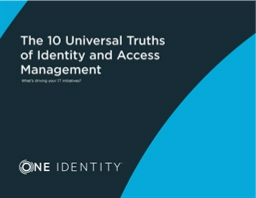The 10 Universal Truths of Identity and Access Management
Most organizations implement technology to do things better, deliver higher value, fulfill their mission and become more agile.
After all, technology should make things easier. But often it seems that many IT initiatives slow operations and hamstring agility.
IAM is an ever-moving target that has become a large and integral part of IT operations.
The following ten universal truths of IAM provide common-sense guidance on how to evaluate your need, implement a solid IAM solution and optimize its usage.
Read More
By submitting this form you agree to One Identity contacting you with marketing-related emails or by telephone. You may unsubscribe at any time. One Identity web sites and communications are subject to their Privacy Notice.
By requesting this resource you agree to our terms of use. All data is protected by our Privacy Notice. If you have any further questions please email dataprotection@techpublishhub.com
Related Categories: Big Data, Business Intelligence (BI), Business Process Management, BYOD, Cloud Computing, Collaboration, Compliance, Consumerization of IT, Content Management Systems (CMS), Data Center, Data Centers, Data management, Data Warehousing, Databases, Enterprise Resource Planning (ERP), Finance & Finance Management, Firewall, Infrastructure Management, IT Management, Project Management, SDDC, Server, Service Level Management, Service Management, Storage, Virtualization, VPN


More resources from One Identity

IAM for the Real World: Identity Governance
In the real world, governance is a major challenge.
In fact, governance can't even be considered until access, security, control and manageme...

The 12 Critical Questions You Need to Ask Whe...
Most enterprises today have heterogeneous IT environments, with Microsoft Active Directory (AD) providing Windows access for most users, but with o...

The Best of Both Worlds: Hybrid IAM Offers Fl...
One of the fastest growing segments of the Identity and Access Management (IAM) market is the cloud segment.
Increasingly, companies are choo...